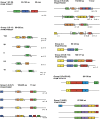The enigmatic LEA proteins and other hydrophilins
- PMID: 18772351
- PMCID: PMC2528095
- DOI: 10.1104/pp.108.120725
The enigmatic LEA proteins and other hydrophilins
Figures



References
-
- Ali-Benali MA, Alary R, Joudrier P, Gautier MF (2005) Comparative expression of five LEA genes during wheat seed development and in response to abiotic stresses by real-time quantitative RT-PCR. Biochim Biophys Acta 1730 56–65 - PubMed
-
- Alpert P (2005) The limits and frontiers of desiccation-tolerant life. Integr Comp Biol 45 685–695 - PubMed
-
- Alpert P, Oliver MJ (2002) Drying without dying. In M Black, HW Prichard, eds, Desiccation and Survival in Plants. CAB International, Wallingford, UK, pp 3–43
-
- Alsheikh MK, Heyen BJ, Randall SK (2003) Ion binding properties of the dehydrin ERD14 are dependent upon phosphorylation. J Biol Chem 278 40882–40889 - PubMed
Publication types
MeSH terms
Substances
LinkOut - more resources
Full Text Sources
Other Literature Sources

